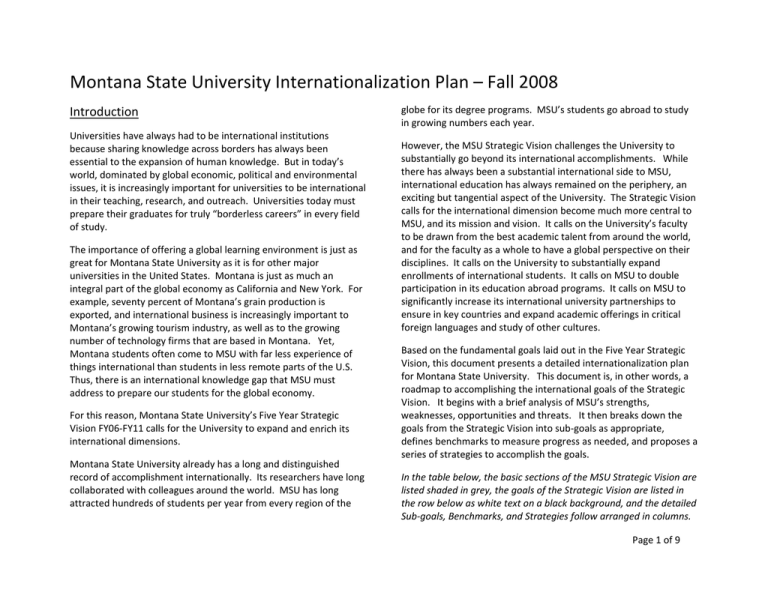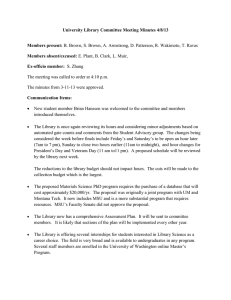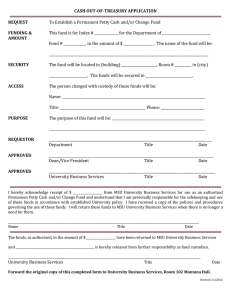Montana State University Internationalization Plan
advertisement

Montana State University Internationalization Plan – Fall 2008 Introduction Universities have always had to be international institutions because sharing knowledge across borders has always been essential to the expansion of human knowledge. But in today’s world, dominated by global economic, political and environmental issues, it is increasingly important for universities to be international in their teaching, research, and outreach. Universities today must prepare their graduates for truly “borderless careers” in every field of study. The importance of offering a global learning environment is just as great for Montana State University as it is for other major universities in the United States. Montana is just as much an integral part of the global economy as California and New York. For example, seventy percent of Montana’s grain production is exported, and international business is increasingly important to Montana’s growing tourism industry, as well as to the growing number of technology firms that are based in Montana. Yet, Montana students often come to MSU with far less experience of things international than students in less remote parts of the U.S. Thus, there is an international knowledge gap that MSU must address to prepare our students for the global economy. For this reason, Montana State University’s Five Year Strategic Vision FY06‐FY11 calls for the University to expand and enrich its international dimensions. Montana State University already has a long and distinguished record of accomplishment internationally. Its researchers have long collaborated with colleagues around the world. MSU has long attracted hundreds of students per year from every region of the globe for its degree programs. MSU’s students go abroad to study in growing numbers each year. However, the MSU Strategic Vision challenges the University to substantially go beyond its international accomplishments. While there has always been a substantial international side to MSU, international education has always remained on the periphery, an exciting but tangential aspect of the University. The Strategic Vision calls for the international dimension become much more central to MSU, and its mission and vision. It calls on the University’s faculty to be drawn from the best academic talent from around the world, and for the faculty as a whole to have a global perspective on their disciplines. It calls on the University to substantially expand enrollments of international students. It calls on MSU to double participation in its education abroad programs. It calls on MSU to significantly increase its international university partnerships to ensure in key countries and expand academic offerings in critical foreign languages and study of other cultures. Based on the fundamental goals laid out in the Five Year Strategic Vision, this document presents a detailed internationalization plan for Montana State University. This document is, in other words, a roadmap to accomplishing the international goals of the Strategic Vision. It begins with a brief analysis of MSU’s strengths, weaknesses, opportunities and threats. It then breaks down the goals from the Strategic Vision into sub‐goals as appropriate, defines benchmarks to measure progress as needed, and proposes a series of strategies to accomplish the goals. In the table below, the basic sections of the MSU Strategic Vision are listed shaded in grey, the goals of the Strategic Vision are listed in the row below as white text on a black background, and the detailed Sub‐goals, Benchmarks, and Strategies follow arranged in columns. Page 1 of 9 Strengths Weaknesses Central leadership commitment to international education Quality of MSU academic programs Faculty dedicated to international programs Competence and entrepreneurial orientation of OIP staff MSU international connections/network Opportunities Threats Increase campus awareness of existing MSU international programs Promote increased faculty involvement‐ e.g. short term study abroad leaders Build on existing Middle East initiatives Increase understanding of implications of globalization for graduates Promote unique location of MSU‐e.g. University of the Yellowstone Build on distance education facilities/expertis Lack of university budget resources Lack of funds for international programs and incentives for faculty, etc. Isolation and lack of awareness of Montana abroad Insufficient campus coordination Lack of programs in key countries (e.g. China and India) Few scholarships for study abroad Increasing cost of international travel Declining value of the US dollar Runaway MSU nonresident tuition Precarious OIP budget and low MSU contribution Lack of support for international education in Montana Threats Increasing cost of international travel Declining value of the US dollar Runaway MSU nonresident tuition Precarious OIP budget and low MSU contribution Page 2 of 9 Lack of support for international education in Montana ` B. Approximately 27% of [MSU’s student body] will be nonresidents, slightly higher than the current 25% nonresident rate (counting Western Undergraduate Exchange and international students). E. The number of international students will increase from 264 (Fall 2005) to 500. Sub‐Goal Strategy Status Benchmarks Strengthen MSU central Establish an International Enrollment Management Deferred The following intermediate benchmarks 1 systems and facilities relating Committee to facilitate a campus‐wide international will be met or exceeded each academic to international students. recruitment effort. year: Target Actual Implement an international student data system integrated Done Fall 2006 300 357 with Banner capable of automated SEVIS data reporting. Fall 2007 350 372 Develop a new data system for enrollment management. Done Fall 2008 400 494 Publish statistics on international student trends at MSU Fall 2009 450 each year. Fall 2010 500 Strengthen communication and information to support the Initiated graduate admissions process, including credential evaluation. Develop with Graduate Studies an on‐line application tracking system (including an on‐line status check for applicants). Secure expanded ESL facilities (classrooms & offices) for Advanced/partially the A.C.E. Language Institute. completed Design “global community” interest floors for residence Deferred halls for international students and other students who want a multi‐national living environment. Position MSU to be more Conduct MSU marketing initiative based on new Carnegie Advanced competitive in the global status as a leading research university designed to reach higher education key stakeholders in foreign educational markets. marketplace. Establish an MSU Offshore Initiatives Committee to explore Deferred options to increase international student enrollments through twinning, dual degree, transnational education and other such programs. Strengthen the role of Survey academic colleges and departments regarding their Done academic colleges and interests, needs, and concerns regarding enrolling more departments in international international students. 1 Includes degree seeking undergraduate and graduate students, ESL students conditionally admitted to MSU, and exchange students. (Does not include students on “optional practical training” still sponsored by MSU for visa purposes). Page 3 of 9 student recruitment. Increase applications from international students and enrollment yield from applications. Increase international retention rates. Sub‐Goal Increase OIP outreach to academic departments through In process presentations on recruitment strategies, and opportunities, market trends, international credentials, etc. Create incentives in college “reallocation” system which Done recognize investments in international recruitment. Remove disincentives for departments to offer GTA/GRA Done awards to international applicants by increasing tuition waivers. Conduct a review of the international recruitment program Done by a leading external international recruitment expert. Develop better market research program to identify In process competitive market niches for MSU. Review scholarship/assistantship opportunities for In process international students to maximize MSU competitiveness. Expand the network of MSU educational advising agencies Done in key countries from 25 to 50. Cultivate additional partnerships with foreign student In process scholarship sponsors. Continue to build articulation agreements and Deferred relationships with two‐year institutions both in the U.S. and abroad, and implement first year incentive scholarships for international transfer students. Conduct an a detailed analysis of international student Deferred retention rates at MSU. Survey international student body for information on Deferred satisfaction with MSU. Develop exit survey for students who transfer to another Deferred U.S. institution. Maximize retention scholarships to prevent international In process students from leaving MSU due to cost factors. II. Faculty and Staff D. Faculty and staff will have increased access to professional development programs and international exchanges. For faculty this will include sabbaticals, BEST awards, and short professional leaves. About ten percent of eligible faculty currently participates in one of these programs. We plan to double that participation to 20%. Strategy Status Benchmark Page 4 of 9 Increase faculty awareness about international professional development opportunities and encourage colleges and department to support their participation in them. Increase participation in the Fulbright Program. Increase faculty opportunities to participate in exchanges with MSU international partner institutions. Increase foreign language Develop a comprehensive data base of international opportunities experiences for faculty and staff on the OIP website. Deferred Create a portal for MSU faculty with interests in international activities. Communicate to department heads and in each academic college the available opportunities for international professional development specific to the college and/or department. Implement a Fulbright Program incentive package to increase faculty applications for Fulbright Scholar Fellowships. Deferred Increase OIP outreach regarding Fulbright opportunities, especially through faculty who have returned to campus from Fulbright experiences. Develop a series of annual/bi‐annual faculty led study abroad programs in cooperation with partner institutions. In process Survey international partner institutions to identify which institutions are interested in conducting faculty exchange or visiting lecturer activities. Provide financial options to use Faculty Short Term Development Leave Program awards in residence at MSU international partners. Encourage faculty and staff to visit MSU partner institutions when abroad by paying for additional expenses. Add faculty exchange opportunities with selected MSU partner institutions, including joint appointments and opportunities for research collaboration Increase the size of the OIP Faculty International Research and Program Development Fund to increase the number of awards to faculty. Encourage faculty and staff to use tuition waivers to learn a At least twenty percent of the MSU faculty will have participated in an international professional development program or exchange program over the period between ’06 to ‘11. Deferred Measurable growth when comparing past years, starting with AY 07‐08 Deferred At least 15 MSU Bozeman faculty members will be awarded Fulbright Fellowships over the five year period between ’07 to ‘11 An OIP web page spotlight for each participant, beginning AY 07‐08 In process Deferred OIP provides guidelines in form of questions to be answered in planning a study abroad AY 07‐08 Assign design of instrument by AY 08‐09 and implements survey in AY 09‐10 Deferred Change in policy by Spring 2011 Deferred In process (with Istanbul Technical University) Deferred Deferred Page 5 of 9 skills of MSU faculty and staff second language Provide HR with a rationale of the benefits of a second language to share with staff. Increase international Develop an annual program for staff including sack lunch Deferred knowledge and competence seminars featuring international speakers, intercultural of the MSU staff communication and culture shock workshops, OIP presentations during Round Table meetings, etc. Develop staff exchange opportunities within MSU Deferred international partnerships, including both short‐term and long‐term options. Increase content on OIP’s webpage to assist staff in dealing In process with international students and scholars Encourage hiring international students within college and Deferred departmental offices Encourage staff to volunteer for the International Street In process Food Bazaar and other international events Increase visibility of OIP and Provide an OIP booth at Catapalooza and other campus Done its services to the MSU staff events attended by staff Utilize MSU News regularly to publicize OIP activities. In process F. A growing proportion of the faculty will have a global perspective on their disciplines and will be active participants in the international development of their fields. The University will increasingly attract a strong and diverse faculty drawn from the best educators, scholars, and researchers throughout the world. Sub‐Goal Increase proportion of the faculty that will have a global perspective of their discipline and will be an active participant in the international development of their fields Strategy Encourage all departments to include demonstrated international experience and interests as at least as a desirable qualification in all faculty position announcements. P&T requirements will include criteria of faculty publications in international journals related to their expertise. Encourage faculty applications to NSF PIRE and other Status Deferred Benchmark Increase proportion of new faculty hires with international experience and perspectives. Deferred 25 % of faculty in every college will belong to international academic associations in their area of specialty in order to publish by 2011. In process Page 6 of 9 Encourage faculty to develop new international courses and to enhance the international content of courses they already teach by provide support for development time and expenses. Attract strong and diverse international faculty Sub‐Goal Participation in study abroad programs will increase from 198 (FY 2005) to 500. competitions that support international research collaboration. Compile examples of international course syllabi to serve as templates. Increase incentives for departments to hire international applicants for faculty positions by subsidizing costs of OIP providing visa application services. Deferred Visible web page to direct faculty (and students!) to international course syllabi. Deferred Increased application when comparing past years starting with AY 07‐08. Increase international faculty exchanges with partner In process Increase in short term and/or sabbatical universities research collaboration. III. Curriculum E. Students will have increasing opportunities to participate in international experiences and participation in study abroad programs will increase from 198 (FY 2005) to 500. Additional opportunities will be offered for students to learn critical languages and study other cultures and global issues. Strategy Status Benchmark Establish Provost’s Study Abroad Fund to provide small travel scholarships designed to pay the differential between studying abroad and staying at MSU. Deferred The following intermediate benchmarks 2 will be met or exceeded each academic year: Page 7 of 9 Encourage development of a study abroad scholarship fund based on a student fee in the range of $1‐ 3/student/semester along the lines of a program originally established at the University of Texas. Implement “bring your passport” with you to MSU campaign to encourage new students to be thinking about study abroad. Increase the number of short‐term faculty led study abroad programs, focusing on topics and locations in high demand and able to attract large student cohorts. Increase funding for study Establish a position of Director of Study Abroad to focus on abroad staffing and expansion of study abroad, outreach to campus academic operations units, and manage providing services for expanded number of study abroad students. Add additional study abroad advisor position to OIP to handle additional workload of increased student numbers. Develop a data base for managing study abroad enrollments and record keeping Establish a comprehensive study abroad center in a central campus location Create additional Expand Arabic language offerings to include at least second opportunities for learning year Modern Standard Arabic, hiring a Modern Language critical languages* Department faculty member in Arabic, who would teach part time in the US Arabic Language Distance Learning *Major world languages of Network administered by OIP. strategic importance to Add Mandarin Chinese as part of development of East business, trade, U.S. security, Asian Studies Program. Hire faculty in Modern Languages including, at a minimum and create a network parallel to the Arabic language languages currently taught at network for Chinese MSU and Mandarin Chinese Submit proposal to Department of Education Foreign Language and International Studies Program to assist establishing Chinese program Create additional Encourage all MSU academic colleges to develop an opportunities for students to internationalization plan if one is not already in place study other cultures and which addresses ways to increase learning opportunities global issues regarding other cultures and global issues. Review CORE 2.0 diversity requirement and/or add Deferred Deferred Fall 2006 250 Fall 2007 325 Fall 2008 400 Fall 2009 450 Fall 2010 500 In process In process Deferred In process Deferred In process In process Done In process Conduct survey of academic units to determine benchmarks for growth. Deferred Page 8 of 9 Sub‐Goal Expand international partnerships in key countries and regions, including China, the Indian Subcontinent, Latin America, and the Middle East/North Africa. international/global requirement. Enhance the Global Studies Minor through a Capstone Deferred Seminar taught at least once per year. Implement proposed expansion of Japanese Studies In process Program to East Asian Studies Program. Establish a curricular development fund to provide support Deferred for enhancing other culture, global issues content to course offerings. V. Partnerships and Outreach J. MSU will develop expanded international partnerships in key countries and regions in order to provide study abroad and exchange opportunities for students and faculty, to increase international diversity on the MSU campus, and to promote international research collaboration. Strategy Benchmark Identify priority regions and countries based on an Deferred analysis of MSU needs and interests and global trends Identify “Flagship Partnerships” which include Deferred faculty and/or staff exchanges and research collaboration. Develop a comprehensive, campus‐wide database Deferred of all international partnerships. Develop a protocol and schedule for evaluating In process current and future study abroad and exchange agreements to ensure they remain vibrant & effective. Page 9 of 9


